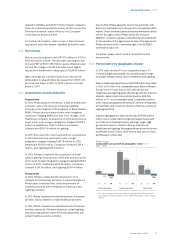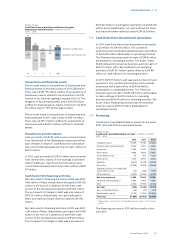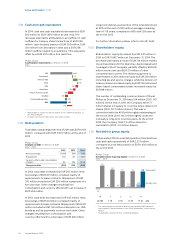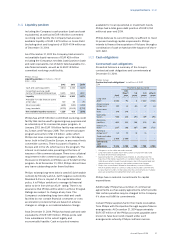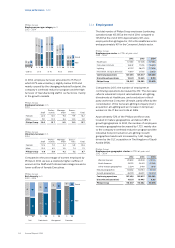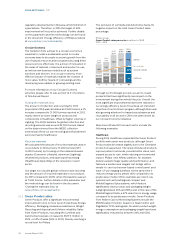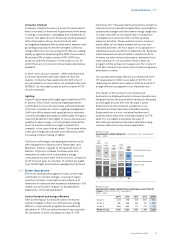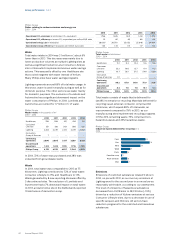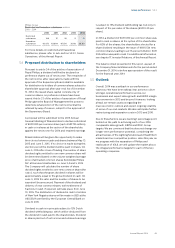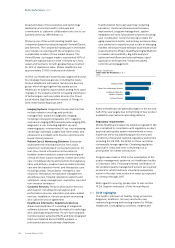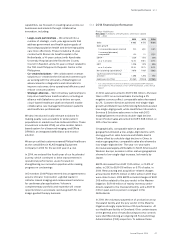Philips 2014 Annual Report Download - page 37
Download and view the complete annual report
Please find page 37 of the 2014 Philips annual report below. You can navigate through the pages in the report by either clicking on the pages listed below, or by using the keyword search tool below to find specific information within the annual report.
Group performance 5.2.10
Annual Report 2014 37
Labor
• Freely chosen employment
• Child labor prohibition
• Working hours
• Wages and benefits
• Humane treatment
• Non-discrimination
• Freedom of association
Health and Safety
• Occupational safety
• Emergency preparedness
• Occupational injury and illness
• Industrial hygiene
• Physically demanding work
• Machine safeguarding
• Sanitation, food and housing
Environmental
• Environmental permits and
reporting
• Pollution prevention and
resource reduction
• Hazardous substances
• Waste water and solid waste
• Air emissions
• Product content restrictions
Ethics
• Business integrity
• No improper advantage
• Disclosure of information
• Intellectual property
• Fair business, advertising and
competition
• Protection of identity
• Responsible sourcing of
minerals
• Privacy
• Non-retaliation
Management system
• Company commitment
• Risk assessment and risk
management
• Management accountability
and responsibility
• Improvement objectives
• Legal and customer
requirements
• Training
• Communication
• Corrective action process
• Worker feedback and
participation
• Documentation and records
• Audits and assessments
• Supplier responsibility
2014 supplier audits in risk countries
In 2014, Philips conducted 203 full-scope audits.
Additionally, 35 audits of potential suppliers were
performed. Potential suppliers are audited as part of
the supplier approval process, and they need to close
any zero-tolerance issues before they can start
delivering to Philips. In our new audit approach, we
place more focus on capacity-building programs to
realize structural improvements leading to better audit
results.
Philips Group
Accumulative number of initial and continual conformance
audits
2005 - 2014
‘05
150
+365
‘06
+166
‘07
+277
‘08
+360
‘09
+273
‘10
+212
‘11
+159
‘12
+200
‘13
+203
‘14 total
2,365
As in previous years, the majority of the audits in 2014
were done in China. The total number of full-scope
audits carried out since we started the program in 2005
is 2,365. This number includes repeated audits (129 in
2014), since we execute a full-scope audit at our risk
suppliers every three years. The audit program covers
90% of our spend with risk suppliers.
Philips Group
Distribution of supplier audits by country
2014
156China
24India
6Mexico
9Brazil
8Other
Audit ndings
We believe it is important to be transparent about the
issues we observe during the audits. Therefore we have
published a detailed list of identied major non-
compliances in our Annual Report since 2010.
To track improvements, Philips measures the
‘compliance rate’ for the identied risk suppliers, i.e. the
percentage of risk suppliers that were audited within
the last three years and do not have any – or have
resolved all – major non-compliances. During 2014 we
achieved a compliance rate of 86% (2013: 77%).
Please refer to sub-section 14.2.8, Supplier indicators,
of this Annual Report for the detailed ndings of 2014.
Supplier development and capacity building
Based on many years of experience with the audit
program, we know that a combination of audits,
capacity building, consequence management and
structural attention from management is crucial to
realize structural and lasting changes at supplier
production sites. In 2014 we continued our focus on
capacity-building initiatives which are oered to help
suppliers improve their practices. Our supplier
sustainability experts in China organized training,
visited suppliers for on-site consultancy, conducted
pre-audit checks and helped suppliers to train their
own employees on topics like occupational health and
safety, emergency preparedness, chemicals
management, dust explosion and prevention, and re
safety.
We also teamed up with peers in the industry and civil
society organizations to work on capacity building at
Chinese factories via the IDH Electronics Program, an
innovative multi-stakeholder initiative sponsored by
the Sustainable Trade Initiative (Initiatief Duurzame
Handel). The goal is to improve working conditions for
more than 500,000 employees in the electronics
sector. Three years ago the program was kicked-o in
China’s Pearl River Delta, and has now expanded to


